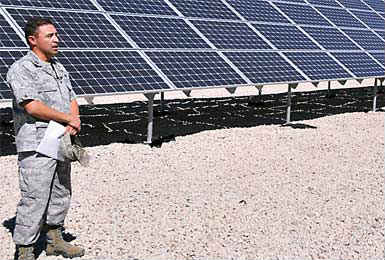The "Green" Light for Military Energy
The Army, Navy, Marines, Air Force, and Coast Guard have each committed to deploy one gigawatt of renewable energy on or near its installations by 2025.
Fall 2012

The Army, Navy, Marines, Air Force, and Coast Guard have each committed to deploy one gigawatt of renewable energy on or near its installations by 2025. Army Secretary John McHugh noted that the Federal Renewable and Alternative Energy contract is expected to provide the Army with the means to achieve its goals.
The Memorandum of Understanding between the Department of Defense and the Department of the Interior noted, "Renewable energy, when combined with advanced micro-grid and storage technologies, can significantly enhance the energy security and reduce the energy costs of DoD installations." Tonju Butler, the procurement contracting officer at the U.S. Army Corps of Engineers, Engineering and Support Center, Huntsville, explained, "It is the intent of the government only to purchase the energy that is produced, and not to acquire any generation assets. The contractors will finance, design, build, operate, own, and maintain the energy plants.Project locations may be on any federal property located within the U.S. including Alaska, Hawaii, territories, provinces, or other property under the control of the U.S. government for the duration of contract performance."
The new developments can consist of many different types of energy generation. The memorandum noted, "Offshore wind is an abundant renewable energy resource available to most DoD coastal installations on the Atlantic Coast, on the Pacific Coast, in the Gulf of Mexico, and in Hawaii." Another bright green energy spot is in the solar sector. Solar panel producer Suntech Power Holdings, Co. Ltd., recently supplied 3.4 megawatts (MW) of solar panels for a solar installation at Edwards Air Force Base in Southern California, with more than 12,000 solar panels manufactured at Suntech's facility in Goodyear, Arizona. The installation was designed, financed, and installed by Borrego Solar, solar solutions provider, at no upfront cost to Edwards Air Force Base. Mike Hall, CEO of Borrego Solar said, "Looking ahead, we are excited to work with more military and federal facility managers to help them take full advantage of the financial benefits that come from using solar to generate clean sustainable energy and local jobs."
In September, California-based SolarCity received a conditional commitment for a partial guarantee of a $344 million loan to help secure financing for its SolarStrong™ project that, in part, partners with military housing-privatization developers to install, own, and operate rooftop solar installations on as many as 124 military housing developments across 33 states. The first eligible project is already under way at Hickam Communities at Joint Base Pearl Harbor-Hickam in Hawaii.
Pike Research estimates that the DoD currently spends approximately $20 billion per year on energy - 75 percent for fuel and 25 percent for facilities and infrastructure, and green energy is an important change. "The DoD is positioned to become the single most important driver of the cleantech revolution in the United States," says Pike Research president Clint Wheelock in a company statement. "In particular, military investment in renewable energy and related technologies can help bridge the `valley of death' that lies between research and development and full commercialization of these technologies."
Project Announcements
Eurofins Lancaster Laboratories Expands Lancaster County, Research Operations
01/03/2026
Valerie Health Plans Chattanooga, Tennessee, Operations
01/02/2026
Samsung Biologics Plans Rockville, Maryland, Manufacturing Operations
12/31/2025
SencorpWhite Plans Hamilton, Ohio, Headquarters-Manufacturing Operations
12/29/2025
Kraken Technologies Limited Plans New York City Headquarters Operations
12/29/2025
Lupin Expands Coral Springs, Florida, Operations
12/29/2025
Most Read
-
The Workforce Bottleneck in America’s Manufacturing Revival
Q4 2025
-
Rethinking Local Governments Through Consolidation and Choice
Q3 2025
-
Data Centers in 2025: When Power Became the Gatekeeper
Q4 2025
-
Lead with Facts, Land the Deal
Q3 2025
-
Tariff Shockwaves Hit the Industrial Sector
Q4 2025
-
Investors Seek Shelter in Food-Focused Real Estate
Q3 2025
-
America’s Aerospace Reboot
Q3 2025



